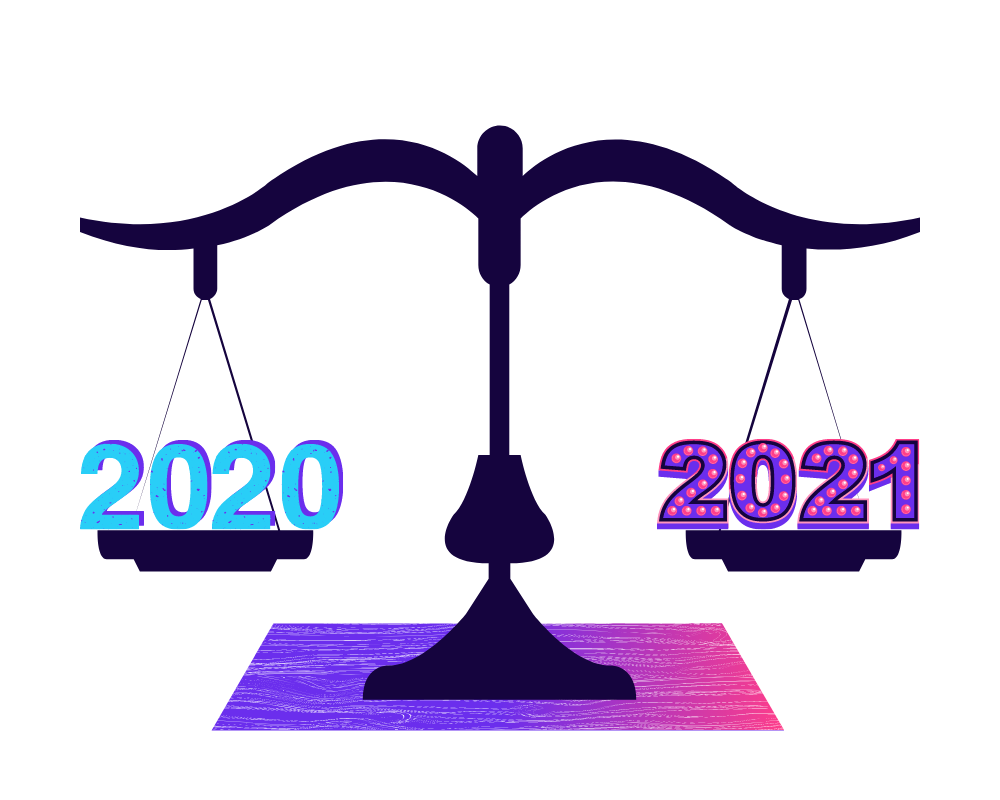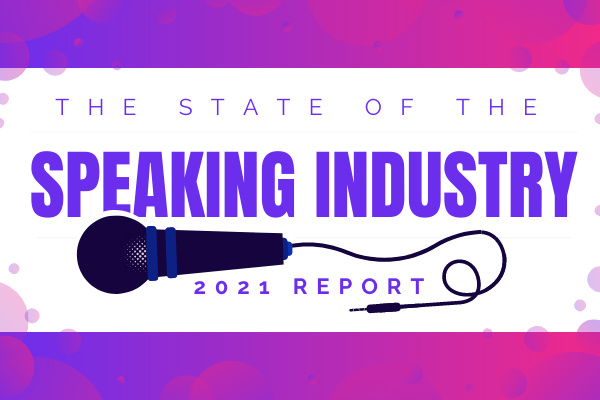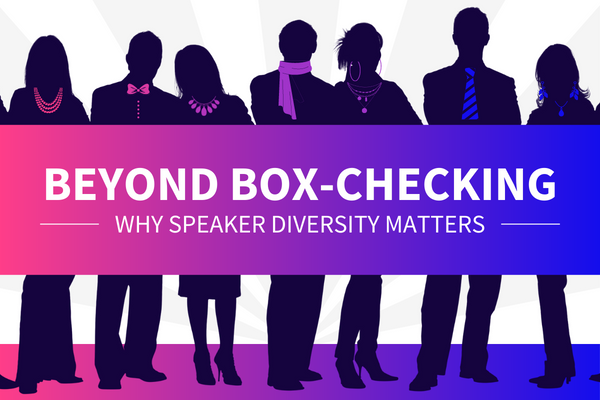Every year, as new innovations and issues emerge, the speaking industry is forced to adapt. Over the last decade, much of that adaptation has involved a greater understanding of technology. In other cases, it’s focused on topics too long ignored, such as sexism or racism in the workplace.
However, regardless of the specific change you look at, one thing is clear: The more data you have, the better you can adapt. It’s also clear that successful speakers tend to be those who execute. In other words, being aware of trends isn’t enough. You have to put them into action, so you can stay ahead of the curve.
To aid in this uphill battle, every year, the SpeakerFlow team conducts their “State of the Speaking Industry” report. In it, we survey hundreds of speakers from around the world to gauge their experience from the previous year. What are their biggest challenges and anxieties around their speaking businesses? What did they do differently in the last year that helped them succeed? How is the industry changing, as a whole, as it becomes more competitive?
The answers to all of these questions – and more – can be found in this year’s 2021 Report. But, for the time being, let’s start small and hit the highlights of 2020. That way, you can get the main ideas now and implement the details later, using the corresponding guide. 👍
Download the Latest Report 👇
We collected insights, trends, and research from thought leaders in every stage of the business.
Here’s what we learned from their experiences in 2022.

Speaking Industry Stats Overview

To start, let’s look at the speaking industry from a bird’s eye view. Of the speakers we surveyed, the vast majority were relatively experienced thought leaders with an existing understanding of the industry. This generally meant speakers with more than a decade of speaking experience. In fact, more than 50% of respondents said they’d been speaking anywhere from 12 to 30 years. Unsurprisingly, this has also been the case with most recent industry data, as more experienced speakers tend to also be active in the channels conducting such surveys.
In addition to basic questions about their careers, we also surveyed participants about their resulting mindsets. This included questions such as: “When it comes to the sales, marketing, or operations of your business, which gives you the most anxiety?” “Rate your confidence in your
ability to operate your business,” and “Rate your confidence in your ability to sell.”
For the most part, these answers mirrored the confidence of an experienced professional. Regarding their business operations, for instance, the majority of participants (60.2%) gave themselves a 7/10 or higher on their ability to run their speaking business. Similarly, regarding sales, 51.8% rated themselves a 6/10 or higher on their ability to sell.
Takeaways:
- Although most speakers are confident in their sales abilities, they’re also most anxious about them. In fact, 50% of respondents said that – between sales, operations, and marketing in their business, sales makes them the most anxious.
- Predictable revenue within the speaking industry remains a problem, as 82% of speakers said their main source of anxiety is revenue-related.
- Despite budgetary setbacks, most successful speakers have still managed on their own. Currently, more than 70% of those we surveyed were solopreneurs, meaning they operate entirely unaccompanied.
- Conversely, for speakers with teams, success doesn’t necessarily demand a large group. On average, speaking teams have fewer than five members. Most often, they have two (excluding the speaker).
Speaker Sales Stats Overview

At this point, you’ve probably gathered that sales is one of the most stress-inducing aspects of professional speaking. You’ve probably heard or experienced many of the common concerns yourself, such as how hard it is to find qualified speaking leads, the increasing difficulty of speaking industry competition, and the overwhelming question of “Which sales technology do I actually need?”
Along those lines, the vast majority of the speakers we surveyed voiced these exact concerns, starting with where their revenue comes from. This stemmed from the fact that 51.8% of respondents attributed the bulk of their business to referrals. It also compounds when you take into consideration the general anxiety surrounding sales, due to concerns such as “not liking the sales process,” “fear of rejection,” and “discomfort with negotiating fees,” according to this report.
More importantly, however, it arose from a lack of diversity in speaking products and services. Keynoting, for instance, was a primary sales offering for more than 70% of participants. Other common speaker offerings – such as workshops and book sales – scored similarly at 59% and 48%, respectively.
This lack of variety, combined with the heavy reliance on referrals, is consistent with results from our 2019 report. It also demonstrates a continuing lack of recognition for the rising popularity of digital resources and products and their revenue potential, either sold on their own or in conjunction with a standard speaking program.
Takeaways:
- Digital products (courses, membership sites, etc.) are still extremely underutilized in the speaking industry. Despite their proven ROI, only 19% of speakers rely on digital products for revenue and only 6% rely on membership sites.
- The prevalence of keynote speaking, as a revenue generation mechanism, is lessening. Due to demand and the effects of the COVID pandemic, keynoting went down 20% since 2019.
- Appropriate sales technology can mean the difference between panic and profit. Of the 54% of respondents that actively use a CRM, most credited it to their ability to stay organized and efficiently close deals.
Comparing 2020 and 2021’s Stats

Looking at annual sales, specifically, much of the data we compiled in our 2021 report mirrored that of 2020. However, as you’d expect – given the COVID-19 pandemic – there were some unique challenges and trends that arose over the last year. We’ll look at the challenges relative to COVID shortly.
In the meantime, considering sales as a whole, many speakers are seeing successes and failures from the same areas. For one thing, despite the wave of event cancellations in March 2020, the majority of speakers (85% of those we surveyed) successfully transitioned into virtual speaking. We also saw an increase in the percentage of speakers charging more than $20,000 per gig, from 1.8% in 2019 to 6% in 2020.
Nevertheless, in comparing 2019 and 2020, the bulk of the stats are slightly pessimistic. As expected, annual revenue declined overall, with the average speaker making between $50-75k in 2020 (versus $75-100k in 2019). In terms of individual gigs, the average fee also decreased, with 69.6% of respondents making less than $5,000 per gig, compared to 55.2% in 2019.
It’s also worth noting that, throughout the year, the average number of gigs (free and paid) dropped dramatically. Regarding free gigs, 50.6% did less than 5 free gigs (versus 61.6% in 2019). Similarly, regarding paid gigs, the most frequent response from survey participants (31.3%) was less than 5 paid gigs. This is a significant drop from 2019’s report, in which most participants counted 50+ gigs/year.
Takeaways:
- The last year was tough for most speakers, economically. In 2020, 28% of respondents made less than $25,000 annually, compared to 17% in 2019.
- Successful speakers weren’t immune from the speaking industry downturn, as 4% of participants made $500,000 or more in 2020 compared to 7% in 2019. Although some of this decrease can be attributed to event cancellations, it also shows a reliance on in-person events for revenue.
- Even though the industry suffered, many speakers continued to give back as much as possible. Looking at free gigs, for example, 28.2% did more than 10 free gigs in 2020 vs 16.4% in 2019
The Effects Of COVID-19 On The Speaking Industry

That brings us to the biggest impact on this year’s speaking industry report: COVID-19. It goes without saying that many of the trends we saw in this report were directly related to the pandemic. Industry-wide annual revenue decreases are one example. Others include the diminished numbers for average gig count and average fee per gig.
That said, one of the positive results of the pandemic was the rise of virtual events. Among those we surveyed, as mentioned above, more than 80% transitioned to virtual speaking. Additionally, the majority (52.2%) said that less than 40% of their gigs canceled while another 40% went virtual.
In total, only about 5% of speakers abandoned their speaking businesses, as a result of COVID. The bulk of the industry instead adapted, finding ways to grow in spite of travel and public health restrictions preventing the usual in-person events. These included building their online presence to make themselves easier to find online and creating more content (free and paid) for their ideal clients.
All of these changes – when considered next to average speaker revenue – are a clear indication of the importance of sales skills, mindset, and positioning. For each of these areas, the more a speaker invested, the greater success they saw in 2020, even with the pandemic.
Takeaways:
- Virtual speaking isn’t going away. Not only did it allow speakers to continue working safely from home. For many, it also helped them make 2020 profitable, as not having to travel allowed them to book more gigs each month.
- It’s imperative that you know how to sell. As long as you control your outreach, you’ll be able to stay afloat, even if the industry takes a hit like it did this past year. This includes mastering your prospecting and sales communication skills.
- Speaking isn’t everything anymore. Now more than ever, companies and organizations don’t simply want to know how you can impact them from the stage. They want your support before and after the event. You can provide coaching, workshops, workbooks, or consulting – whatever helps them turn your original presentation into action.
How You Can Use These Stats to Crush 2021
All in all, while these stats aren’t necessarily a blueprint for 2021, they are a continuation of many trends that have existed in the speaking industry for years. Think the rise of virtual speaking and the increasing value of digital products.
Furthermore, many of the challenges of 2020 were also around long beforehand. Whether you’re facing a lack of predictable revenue, overwhelm from the demands of digital marketing or sales, or simply the need to better organize your speaking business, you’re far from alone. If anything, this report is just further proof that there are thousands of other speakers around the world grappling with the same obstacles you are.
Hopefully, in outlining the takeaways from our 2021 State of the Speaking Industry Report, you can approach those obstacles with more clarity as you begin the year. For more information – and a checklist of actionable steps for your speaking business – download the full PDF.
Additionally, for personalized guidance, book a call with our team! We’re excited for 2021 and eager to share what we know, so you and your team can kick off the year with a bang. 💪
Download the Latest Report 👇
We collected insights, trends, and research from thought leaders in every stage of the business.
Here’s what we learned from their experiences in 2022.







